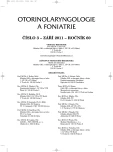-
Medical journals
- Career
Experience with Local Corticoid Therapy in Eustachian Tube Dysfunctions
Authors: K. Malinová 1; D. Janeček 2; L. Lavička 2
Authors‘ workplace: Klinika dětské ORL LF MU a FN Brno 1; ENT – Med. s. r. o., Brno 2
Published in: Otorinolaryngol Foniatr, 60, 2011, No. 3, pp. 157-160.
Category: Original Article
Overview
Local corticoid therapy appears to be a useful method in the therapy of ear diseases. A pharmacological treatment of ET function appears to be problematic and at the present tune it is not commonly used in the Czech Republic or abroad. One possibility is to use corticosteroids (2). A general administration may cause various side effects. A local administration of corticoids in a form of drops directly to the middle ear orifice of Eustachian tube via introduced tympanostomic tube reduces hypotrophy of mucosa and improves the ET function (4). At the present time we offer the patients a local corticoid therapy in cases of sudden hearing disorders, and also to patients with Eustachian tube disorders (ET). The method employed is based on introduction of a tympanostomic tube with a wick – sc. Microwick and the administration of corticoids in the form of drops for the period of several weeks into external auditory duct.
The indicated patients are those with the diagnosis of chronic secretory otitis (OMS). If the chronic secretory otitis lasts or progresses in spite of a previous therapy (introduction of TVT, adenotomy) it requires a repeated treatment, provided clinical and audiological examination proves an ET dysfunction. The patients with the diagnosis of relapsing acute otitis media remain without effects of treatment by a common therapy (adenotomy, introduction of TVT, anthromastoidectomy and vaccination).
The therapy of Eustachian tube dysfunctions by the administration of corticoids via the tympanostomic tube enables to decrease the cost of therapy and subsequent care of the patients with ET function disorders. It is useful in cases, where a common therapy (adenotomy, TVT, anthromastoidectomy) remains without effects. Our results indicate that in all treated patients there was an improvement of hearing and in half of the patients the hearing improved to the level of normal auditory function.Key words:
local corticoid therapy, dysfunction of Eustachian tube, Microwick.
Sources
1. Bluestone, C. D.,Klein, J. O.: Otitis media in infants and children. 2nd ed., Philadelphia, W. B. Saunders, 1, 1995, s. 5-38.
2. Hitler, C. C., van Der Voort, J. H.: Steroids for otitis media with effusion. A systematic rewiew. Arch. Pediatr. Adolesc. Med., 155, 2001, s. 641-647.
3. Sade, J., Ar, A.: Middle ear and auditory tube: Middle ear clearence, gas exchange and pressure regulation. Otolaryngol. Head Neck Surg., 116, 1997, s. 499-524.
4. Silverstein, H. et al.: Direct application of dexamethasone for the treatment of chronic eustachian tube dysfunction. ENT Journal, 82, 2003, č. 1.
5. Silverstein, H., Jackson, L. E., Rosenberg, S. I., Conlon W. S.: Pediatric laser-assisted tympanostomy. Laryngoskope, 111, 2001, s. 905-906.
6. Tos, M.: The intraluminal obstructive pathogenic concept of eustachian tube in secretory otitis media. In Sade J. (ed.): Basic Aspects of the Eustachian Tube and middle ear diseases. Amsterdam, Kugler and Ghedini, 1991, s. 327-333.
Labels
Audiology Paediatric ENT ENT (Otorhinolaryngology)
Article was published inOtorhinolaryngology and Phoniatrics

2011 Issue 3-
All articles in this issue
- Normative Data of Subjective Olfactory Tests for the Czech Population
- Test of Sentence Intelligibility in Babble Noise in Persons with Normal Hearing
- Positron Emission Tomography in ORL Oncology
- Perioperative Monitoring of the Function of Head Nerves in Otorhinolaryngology, Neurootology and Surgery of Cranial Base at the Clinic of ORL and Head Surgery LF UPJŠ a UN L. Pasteur (2000 – 2010)
- Idiopathic and Seemingly Idiopathic Neuralgia of Nervus Trigeminus
- Polyganglionitis Bellʼs Palsy – a Clinical Analysis
- Experience with Local Corticoid Therapy in Eustachian Tube Dysfunctions
- Rare Congenital Neck Anomaly: Aneurysm of the Jugular Vein
- Unusual Coincidence of the Hereditary Angioedema, Systemic Lupus Erythematodes and Tongue Carcinoma
- A Rear Cause of Blindness in a Patient with Nasal Polyposis. Leber’s Hereditary Optic Atrophy of Visual Nerve
- Otorhinolaryngology and Phoniatrics
- Journal archive
- Current issue
- Online only
- About the journal
Most read in this issue- Experience with Local Corticoid Therapy in Eustachian Tube Dysfunctions
- Idiopathic and Seemingly Idiopathic Neuralgia of Nervus Trigeminus
- Rare Congenital Neck Anomaly: Aneurysm of the Jugular Vein
- Polyganglionitis Bellʼs Palsy – a Clinical Analysis
Login#ADS_BOTTOM_SCRIPTS#Forgotten passwordEnter the email address that you registered with. We will send you instructions on how to set a new password.
- Career

